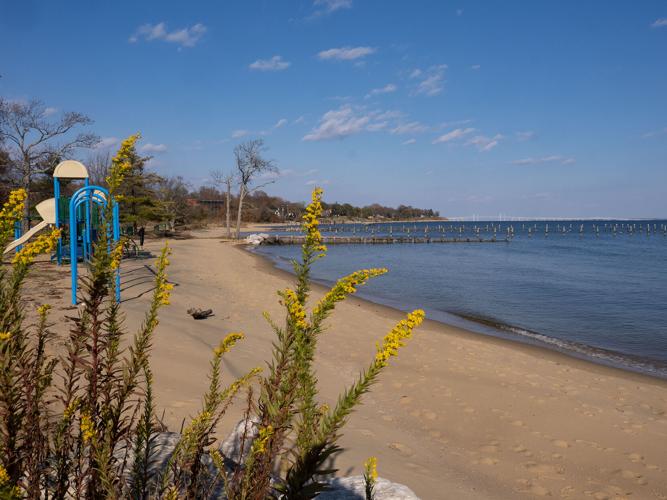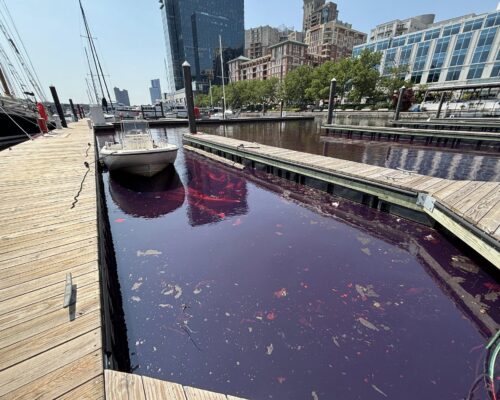By Jeremy Cox, Bay Journal News Service
Highland Beach, a historic black town in Anne Arundel County, Md., is washing away into the Chesapeake Bay, giving ground at a rate of more than 2 feet per year.
Leaders of the Maryland town’s government responded earlier this year with a fix: a $1.2 million effort that included widening a key section of the beach and installing stone fortifications just offshore to deflect wave-driven erosion. During a virtual public meeting last February, a consultant displayed photos of the flooding caused in October 2021 by a no-name storm that pummeled the beach with nearly 5-foot-high waves.
“That’s the kind of wave impact that this system should easily accommodate,” said C. Scott Hardaway, head of the Virginia Institute of Marine Science’s (VIMS) Shoreline Studies Program.
But it might not get a chance to do that. The town shelved the project in September after several residents raised questions about the work. Their concerns centered on future maintenance costs and whether the new structures would mar their picturesque views of the Bay.
Officials say that the criticism didn’t ramp up until after the town submitted permit applications in June to the U.S. Army Corps of Engineers and the Maryland Department of the Environment.
“We were truly blindsided eight months into the project,” said Zora Lathan, the town’s environmental consultant and wife of its mayor, Bill Sanders. “Citizens were just so adamantly against the project. They may not be the majority, but they are loud.”
The town returned the $7,500 it had been awarded by the Maryland Department of Natural Resource’s climate resilience grant program. The money was going to finance the project’s design.
Highland Beach had been one of 12 recipients of the funding awarded in July. The town had to absorb the $20,000 it had already laid out in planning costs.
Town leaders had also applied for a $1 million construction grant through the National Fish and Wildlife Foundation. But they have since notified the organization that they are no longer seeking the funding.
Lathan isn’t ready to declare the project dead in the water. The community of about 120 full-time residents and 500 seasonal occupants still faces a serious erosion problem, and something needs to be done, she said. Once the narrow strip of sand disappears, the town’s only protection will be the stony barrier that parallels Wayman Avenue, its waterfront drive.
“It’s not only a matter of protecting the beachfront and retaining more sand,” Lathan said. “It’s a matter of protecting the road and protecting the properties along the road.”
History may be at stake, too. The community was founded in 1893 by famed abolitionist Frederick Douglass’ eldest son, Charles, and his wife, Laura, as a summertime refuge from Jim Crow-era segregation. Prominent visitors have included writer Paul Laurence Dunbar, poet Langston Hughes, actor Paul Robeson and jurist Thurgood Marshall. This year marks the 100th anniversary of its incorporation as the state’s first African American town.
The community also stands out for its staunch repudiation of dense development. Cottages remain the dominant figure on the landscape. A two-lot minimum for building, being challenged in court, helps keep its bucolic character intact.
Despite the town’s name, much of Highland Beach’s land is low in elevation and vulnerable to flooding caused by storm surges. That is increasingly the case because the Chesapeake has risen by half a foot in the past 30 years and is on track to rise by 1.5 feet over the next 30 years, Hardaway said during his February presentation.
Highland Beach’s shore is especially prone to erosion because it faces due east, away from any land on the Western Shore that might blunt the impact of wind and waves, Hardaway said. Having such a long fetch all but ensures the community experiences some of the region’s highest waves during nor’easters.
The beach also cannot replenish itself with sand as it normally would. Barriers constructed decades ago on the land side of the shoreline are preventing sediment from getting washed onto the beach, Hardaway said. The town estimates it has lost 50 feet of beachfront over the past 25 years.
To remedy that, Hardaway had proposed constructing a “living shoreline,” a mixture of stone, fill and plants. The project would add 3,400 tons of rock, 7,000 cubic yards of sand and 15,000 dune plants along a 600-foot stretch of beach.
But as details of the plan grew clearer, some residents’ concerns grew larger. Many who are seasonal residents were chagrined to discover when they returned in the summer that the project was poised to go forward.
“We had questions that we weren’t able to grapple with—what this would look like, what ultimately the maintenance would be, the view of the Bay as we drove by,” said Charles Newton, president of the Highland Beach Citizens Association. “We just felt like we needed more time to digest that.”
The town’s annual budget can’t take too many financial hits, so maintenance costs must be kept to a minimum, he said. During the February meeting, Hardaway acknowledged that sand would likely need to be replenished from time to time, but he said that most projects he has worked on over the years have required relatively little upkeep.
To address complaints about impacts to the view, the town agreed to lower the height of the stone breakwaters by a foot, down to 4.5 feet above the average low-tide level. If the project is to be resurrected, it’s likely that more concessions will be necessary.




